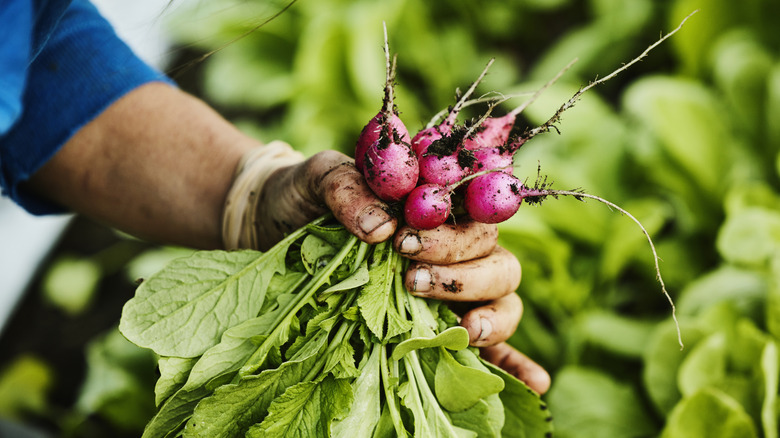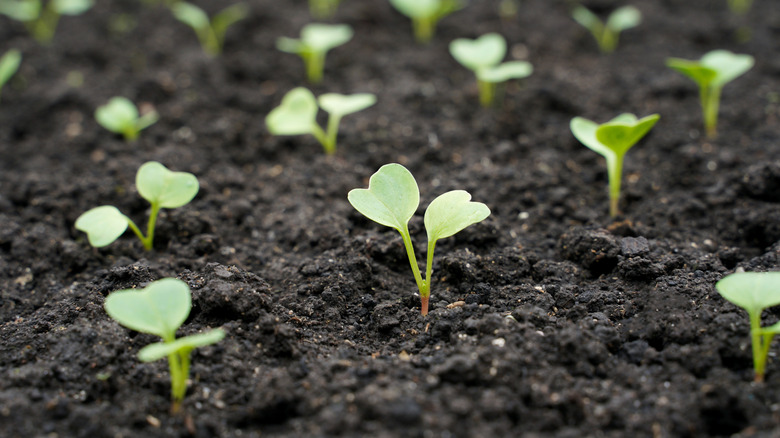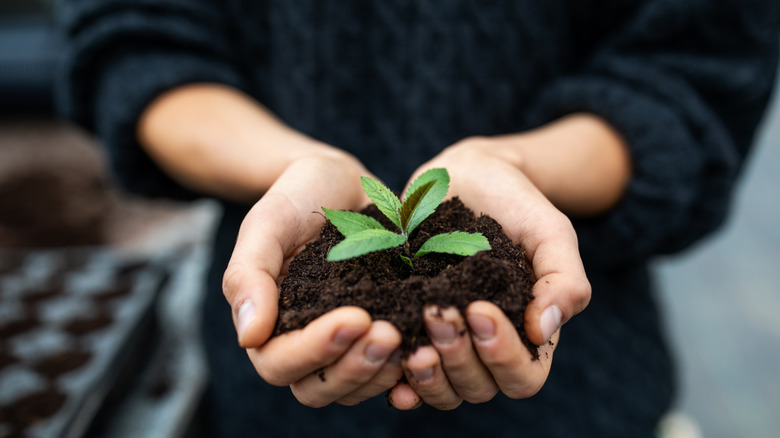The Surprising Way A Radish Can Tell If Your Homemade Compost Is Ready To Use
Making your own homemade compost is a fun and sustainable way of using your leftovers to benefit your garden. Egg shells, coffee grounds, citrus peels, and veggie scraps can all be given a second life when used for a compost pile. A compost pile can even be a creative way to dispose of dead leaves in the fall. But before you start applying your homemade compost to your plants, you need to know if it's actually ready or not. The key? Radish seeds.
Using unfinished compost on your plants can harm them. That's because as compost decomposes, it uses up nitrogen — a soil nutrient that finished compost should be adding to your plants rather than taking away from them. Unfinished compost will cause nitrogen deficiency in your plants, which can damage them and stunt their growth over time. That's why it's so essential to be absolutely certain that your compost is finished before you start using it.
However, visual signs that your compost is ready can be hard to follow. Sure, some compost turns perfectly crumbly and black when it's finished, but others retain components that don't look decomposed at all. So, gardeners devised an actual foolproof way to tell if your compost is ready. By planting radish seeds on top of your compost pile, you can use the seeds' growth to see if your pile is finished or still needs more time to decompose.
How to use radish seeds to see if your compost pile is ready
When you think your compost pile is finished, grab a handful of radish seeds and plant them directly on top of the pile. If the seeds start to sprout and germinate, then congratulations — your compost pile is ready to use in your garden. You can then transplant the radish seeds that have germinated, or you can even eat them as microgreens.
If your radish seeds don't sprout within 10 days, you'll know that your compost pile isn't ready quite yet. That's because unfinished compost is quite toxic to young seedlings, so your radish seeds will die before ever sprouting. Give your compost pile more time to decompose, and then try again with a new batch of seeds.
Note that, in some cases, your seedlings might sprout but not quite look healthy. If your seedlings emerge and their leaves are already yellow or browning, then your compost might still be deficient in some nutrients. In that case, it's best to discard your radish seedlings and continue waiting for the compost to be finished. Fortunately, this is at least a sure sign that your compost is nearing completion.
Why use radishes?
The key to germinating seeds in a compost pile is finding seeds that grow quickly. If you suspect your compost pile is ready to be used, you probably aren't interested in waiting several weeks to see if your seeds sprout or not. Radishes are a great seed for quickly discovering whether your compost is finished because they typically sprout in under 10 days. You could be waiting as little as a few days to tell whether your compost is ready.
If you're not interested in growing radishes, you could always try growing lettuce in your compost bin instead, as lettuce generally also has a germination time of under 10 days. Green beans are also known for sprouting quickly. Interested in traditional microgreens? Broccoli microgreens sprout quickly and take just 10 to 14 days to be ready to harvest. You could even try planting fast-growing flowers like marigolds in your compost bin. Just remember that you should always transplant the seedlings into starter pots once they've germinated so that you can use your compost without disturbing your new sprouts.
When placing the seeds in your compost, either plant a small number of seeds at the very top of the bin, or take a few handfuls of compost, add them to a pot or planter, and attempt to germinate your seedlings inside the separate container. The reason the placement is important is that if you have a lot of extra seeds left in your compost pile, you could wind up with stray radishes popping up throughout your garden wherever you use your compost!


